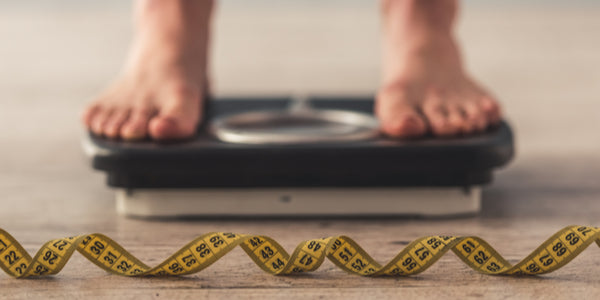
If you're still relying on BMI or the scale to answer "What is a healthy body fat percentage?" we highly encourage you to stick with us.
Yes, such metrics can help estimate changes in weight, but other methods of measuring body composition are more helpful. Body fat percentage, in particular, can help identify how the body is changing. And learning how to calculate body fat percentage can help make your weight loss and health journey more meaningful.
So join me, a dietitian, as I help you navigate the ins and outs of body fat percentages.
What Is Body Fat Percentage?
When evaluating body weight, there are many ways to measure changes. While body mass index (BMI) can help estimate weight status, it’s a simple screening tool that does not completely measure body fatness.
On the other hand, body fat percentage can provide a more precise picture of body composition by analyzing the amount of fat tissue in the body. In other words, it gives more insight into exactly what types of tissues make up the body instead of providing just a rough estimate based on height and weight.
When measuring body composition, there are two main types of tissue analyzed. Fat mass, also called fat tissue or adipose, is what body fat percentage is a measure of. Non-fat mass, which includes lean muscle mass and bone, measures the amount of tissues other than fat.
So, why choose a measure like body fat percentage over BMI? Body fat percentage is a more individualized way to learn about your body and how it's changing. For example, athletes use body fat percentages frequently to assess progress, especially since a taller height or increase in muscle weight may mistakenly categorize them as “overweight” or “obese.”
The opposite can be true, too. Someone with too much body fat may have a “normal” BMI but may have an increased risk for disorders associated with having too much body fat. Measuring body fat percentage over time and tracking trends can be helpful, especially since life stages like puberty or pregnancy can affect the amount of body fat being stored by the body.
What Is a Healthy Body Fat Percentage?
Instead of BMI ranges, body fat percentages can help you understand what is healthy based on your lifestyle. There is an essential amount of fat, that the body needs to function properly.
Beyond that, you may want to aim for a specific body fat range depending on your activity. For example, athletes may want an “excellent” body fat percentage, while the average person may be pleased by falling within a “good” or “acceptable” range.
Female Body Fat Percentage
Interestingly, men and women carry different amounts of fat on their bodies. Females typically have a higher body fat percentage, meaning a woman will likely have more body fat than a man of the same age. Women are also more likely to have less muscle mass than men, which can skew more basic methods like BMI.
Unfortunately, it’s believed (based on recent research) that women may be more prone to worry about their weight and body fat. Understanding target body fat percentages can help women make informed choices when it comes to addressing body fat, instead of aiming for an unattainable ideal.
Here are the different categories of body composition for women, by age (when applicable):
• Essential: 10-13%
• Excellent/Athletes 14-20%
• 20-29: 15-16%
• 30-39: 16-17%
• 40-49: 17-18%
• 50+: 19-22%
• 20-29: 17-24%
• 30-39: 18-25%
• 40-49: 20-27%
• 50+: 22- 31%
•20-29: 24-29%
•30-39: 26-30%
•40-49: 28-32%
•50+: 31-34%
Remember that during certain life stages, such as pregnancy or menopause, the amount of recommended body fat may change. Working with your personal healthcare providers—like doctors and dietitians—is important to ensure you’re receiving individualized advice for your specific needs.
Male Body Fat Percentage
As mentioned above, men typically carry less fat than women. However, like women, they need a certain amount of essential body fat for their bodies to operate properly.
Here are the different categories of body composition for men, by age (when applicable):
• Essential: 2-5
• Excellent/Athletes: 6-13%
• 20-29: 8-11%
• 30-39: 13-15%
• 40-49: 15-18%
• 50+: 17-20%
• 20-29: 12-19%
• 30-39: 16-22%
• 40-49: 19-24%
• 50+: 20-26%
• 20-29: 20-23%
• 30-39: 22-25%
• 40-49: 24-27%
• 50+: 26-29%
How to Calculate Body Fat Percentage
While no body fat measurement method exists without a margin of error, body fat percentage can give you important clues about your health. Some methods are used by researchers in study settings, while others are more inexpensive and can even be conducted at home.
Using A Skinfold Caliper
One popular method used to measure body fat percentage is a skinfold measure. As the name implies, a skinfold caliper is a special tool used to measure the amount of fat in a skinfold.
Essentially, the skin is slightly pinched, and a measurement of skin fat—in at least three different areas of the body–is used to estimate the overall body fat percentage of the body.
Skinfold measurements operate under the assumption that body fat is distributed relatively equally all over the body. They are most accurate when conducted by trained medical professionals.
A drawback of this method is that it relies on subcutaneous fat, which is the layer of fat just below the skin's surface. It tends to accumulate around the following areas of the body:
• Hips and waist
• Upper back
• Buttocks
• Thighs
Although subcutaneous fat is the most abundant type of fat in the body, it’s different from visceral fat. Instead of lying beneath the skin’s surface, visceral fat accumulates around organs in the abdominal cavity.
While increased visceral fat is more significantly associated with a higher risk of conditions like heart disease, diabetes, and certain cancers, subcutaneous fat is also linked with increased disease risk.
In other words, a skinfold measurement can still give you a good idea of body fat percentage. It’s also a more affordable and accessible way to estimate body fat, compared to more intense or invasive body composition techniques.
Underwater (Hydrostatic) Weighing
Underwater weighing (also known as densitometry) to estimate fat may sound more like science fiction than science. Since fat is less dense than water, weighing an individual on land than in the water can help trained professionals estimate body fat. This method is most often used in research settings, especially since formulas are used to measure body volume and density (in addition to body fat).
Still sounds too complex? Basically, lean individuals will weigh more underwater than they do on land. This is because muscle mass weighs more than fat regarding volume.
While this method is more highly accurate, it can be quite costly. In other words, it’s not the most accessible method. Individuals being weighed must also completely submerge themselves in the water, which may be difficult for some individuals.
DEXA & Other Scans
Like underwater weighing, dual-energy X-ray absorptiometry (DEXA) scans are generally used in research. As its full name implies, a DEXA scan uses X-ray beams (which pass through different body tissues at different rates) to estimate the amount of fat mass and fat-free mass.
Unfortunately, this method can’t be used on everyone. Since X-rays use radiation, they are considered more dangerous for sensitive populations, such as children or pregnant women. DEXA machines are also quite expensive and heavy, so many facilities have difficulty obtaining one.
Although DEXA scans can’t distinguish between subcutaneous and visceral fat, they are considered an accurate method of estimating body fat. They can help track progress over time, and also give you clues about the amount and health of other tissues, such as bone and muscle.
Other types of scans can also help give you clues. Occasionally, computerized tomography (CT) and magnetic resonance imaging (MRI) are used to measure body fat. Interestingly, these scans are often considered the most accurate, since they can measure the fat in certain body areas (like the abdomen).
Like DEXA scans, CT scans and MRIs are often used by researchers. Fortunately, many hospitals have this equipment, so it may be easier to access, although not always affordable. CT scans are also not designed for pregnant women or children.
Calculators & At-Home Tools
Wondering whether there are any at-home methods you can use? Although not the most accurate, taking simple tape measurements may help you understand the amount of fat on your body.
Surprisingly, some scientists suggest that body and waist circumference measurements may be more accurate than BMI when it comes to estimating body fat. Waist circumference, in particular, uses a tape measure to measure waist size. Since the measurement is taken around the abdominal area, it may take visceral fat into account, which is more closely related to markers of metabolic health.
Body fat calculators are also accessible in an at-home setting. The American Council on Exercise has a handy body fat percentage calculator that can be used online if you have a skinfold caliper at home. Many calipers designed for personal use cost between $5 to $15.
Don’t have a caliper? No need to worry. The National Academy of Sports Medicine also has a body fat calculator that uses height, weight, neck circumference, and waist circumference (all of which can be measured by a basic tape measure).
Should You Calculate Body Fat?
As with other medical measurements, body fat percentage isn’t the only important assessment for health. In other words, it’s not an “end-all, be-all” and shouldn’t be the only measurement to estimate ideal body fat percentages before changing body composition.
However, body fat percentage can provide a nearly accurate number that can influence health choices. For example, finding your body fat percentage can help you figure out where to start if you're trying to lose weight. As mentioned above, body fat percentage can also give you clues about overall health.
Risks of High and Low Body Fat
Excessive body fat is linked to many weight-related diseases and health problems. High percentages of body fat can increase the risk for the following weight-related conditions:
• Breathing problems such as asthma and sleep apnea
• Cardiovascular (heart) disease
• Certain cancers
• High blood pressure and stroke
• High cholesterol or triglycerides
• Metabolic syndrome
• Organ diseases like fatty liver disease, gallbladder disease, kidney disease
• Osteoarthritis
• Type 2 diabetes
On the other hand, being underweight is also associated with adverse health conditions. It’s important to point out that, no matter your body fat percentage, fat is a nutrient needed to help the body function normally.
Healthy Body Fat Percentage: Final Takeaways
Body fat percentage is useful, and it has advantages over other measurements (like BMI). Some methods are mainly used by researchers, while skinfold calipers or tape measurements may be used to assist in at-home measurements or online calculations.
If you’re struggling to understand body fat percentage, work with an expert to find the ideal range for you.






